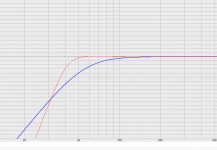From the AES paper that GM posted - "the port pressure is in phase with velocity, the output of the port (which is now in phase with the back side of the cone) will be 180 degrees out of phase with the front of the cone. In this condition the output in the far field could approach zero in a bass reflex speaker"
I'm curious about Far field bass Cancellation - Comparing a Ported system vs a sealed system, both having an equal bass curve. Will the sealed system produce more even bass throughout the room?
I'm curious about Far field bass Cancellation - Comparing a Ported system vs a sealed system, both having an equal bass curve. Will the sealed system produce more even bass throughout the room?
Assuming an equal frequency response (bass curve?) and the output from the port and cone within 1/4 wavelength of each other, room response would also be identical for a sealed or ported system.I'm curious about Far field bass Cancellation - Comparing a Ported system vs a sealed system, both having an equal bass curve. Will the sealed system produce more even bass throughout the room?
I think it needs to be kept in mind that the amplitude of the port output is significantly higher than that coming from the woofer. At the port resonance frequency, the displacement of the woofer is very close to zero, so it is not producing much output. Hence, if the pressure output from the port output is P, and the output from the woofer is P/10, then P – P/10 = 0.9P, which shows that the cancellation effect is quite small, less than 1dB in this example.From the AES paper that GM posted - "the port pressure is in phase with velocity, the output of the port (which is now in phase with the back side of the cone) will be 180 degrees out of phase with the front of the cone. In this condition the output in the far field could approach zero in a bass reflex speaker".
The sealed system has a 2nd-order, 12dB/octave roll-off below the cutoff frequency. This may tend to complement the effects of room gain, which comes in progressively at low frequencies. A sealed enclosure usually has a higher cutoff frequency than a vented enclosure of the same size, hence the boost from room gain supports the bass response to achieve a flatter in-room response than would occur with a vented enclosure. Of course, a small adjustment using the bass tone control can bring the vented enclosure into line and make it appear more like a sealed enclosure.I'm curious about Far field bass Cancellation - Comparing a Ported system vs a sealed system, both having an equal bass curve. Will the sealed system produce more even bass throughout the room?
I have a sealed and ported speaker for testing and comparison. Red is ported in 20 Liters and blue is sealed is 45 liters.. My in room measurements reveal that the sealed speaker has near identical low frequency extension to the ported speaker. Seems to align with witwalds explanation.. I continue to examine all aspects of in room bass performance and qualities🙂
Attachments
Yes, that was probably a paper by my first boss Jim Novak when he was a young man in like the 1950s, as old as this original post ha ha. It was a crude rule of thumb as they still worked their way about what was really going on with speakers. This was before Thiele and Small (and Benson!) had their insights regarding speakers functioning somewhat like electrical filters. In today's real life, a port with that much area would probably be hugely long and have multiple resonances.I am sure I read somewhere that the port area should be the same as cone area.
No I don't think it does. The ported one should NOT have the same curve in the room, it should be elevated. But you can't compare the simulation versus actual measurements. You'd have to measure the actual response of each box. Likely in the near field-easy for the sealed box. For the ported box it's more complex because you have to scale the outputs as the ratio of the areas (or is it the square? I forget exactly, haven't done it in a long time).I have a sealed and ported speaker for testing and comparison. Red is ported in 20 Liters and blue is sealed is 45 liters.. My in room measurements reveal that the sealed speaker has near identical low frequency extension to the ported speaker. Seems to align with witwalds explanation.. I continue to examine all aspects of in room bass performance and qualities🙂
"My in room measurements reveal" I expected the the acoustic measurements to resemble the sims, of course with addition/subtraction of room response but with noticeable lower frequency extension from ported vs sealed.. I will measure nearfield of both speakers and take look at 2m from both.. Thanks!
- Home
- Loudspeakers
- Subwoofers
- Port area vs efficiency.
